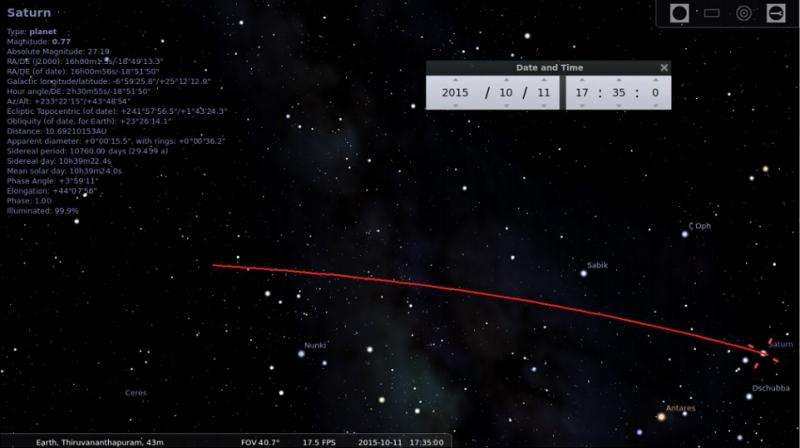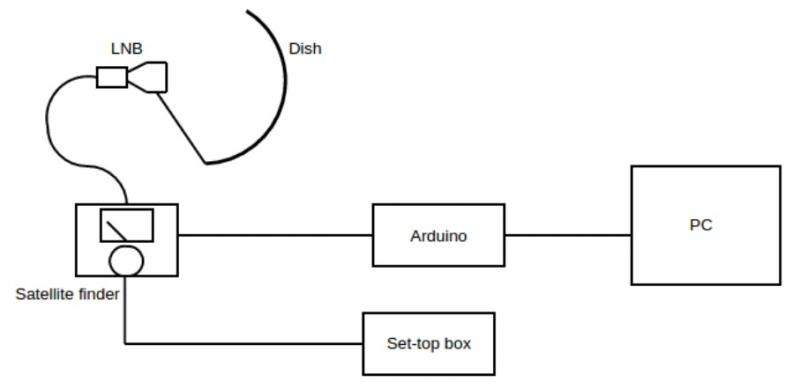The red line show the approximate path traced by the field of view of the telescope during observations. The coordinate of Saturn at the time of it’s passing is shown on top left corner. Credit: Pranshu Mandal et al., 2016.
(Phys.org)—A team of undergraduates from the Indian Institute of Science Education and Research (IISER) at the College of Engineering in Trivandrum, India, has designed and constructed a portable college-level radio telescope for amateur radio astronomers. The students have developed a radio telescope and also data analysis tools that are affordable for schools and colleges, combining low cost and ubiquitous accessibility of resources needed to build these instruments. The team described the project in details in a paper published online on Jan. 12 on the arXiv pre-print server.
"The telescope is dedicated to amateur radio astronomers ranging from high school students to college graduates," Devansh Agarwal, one of the co-authors of the paper, told Phys.org.
While large radio telescopes are needed to detect radio waves from astronomical sources, the students have shown that a small one could also make great discoveries in the field of radio astronomy. A small radio telescope designed by the team was able to measure the brightness temperature of the sun. The scientists also demonstrated the usefulness of their telescope by detecting point sources such as Saturn and extended sources such as the galactic arm of our home galaxy Milky Way.
The team revealed that by performing drift scans, the brightness temperature of the sun was calculated to near 10,000 K with a maximum error of 3.23 percent. Sources like Saturn and the galactic arm were confirmed by correlating the time of arrival of the source signal in the field of view of the telescope with the predicted times via free, open-source planetarium software called Stellarium, based on the team's pointing. The flux received from the sources was calibrated against the standardized data from various geostationary satellites.
Agarwal notes that their radio telescope reached expectations when studying the sun and also works very well when detecting other astronomical sources.
The radio telescope designed by IISER students consists of a satellite antenna, a satellite signal meter called 'satellite finder' and a microcontroller board named Arduino Uno.
Block diagram of the radio telescope setup. Credit: Pranshu Mandal et al., 2016.
The antenna has a 68 cm parabolic dish reflector and a low noise block (LNB). According to the paper, LNB receives the radio signal from the satellite reflected by the dish and amplifies it. There is also a set-top box that powers the satellite finder and the LNB.
Satellite finder is used for orienting satellite dishes towards geostationary satellites.
"We have used a commercially available analog satellite finder (GC SF-02). Such a device acts as a square law detector and is used to read directly the intensity," the team wrote in the paper.
Arduino Uno is a microcontroller board with a 10 bit analog to digital converter. It enables digitizing the intensity from the satellite finder at 10Hz sampling rate. The tool is connected to a personal computer.
The students emphasize that their radio telescope, assembled from commonplace items, is an affordable and a versatile instrument to demonstrate the working of a radio telescope and to provide crucial hands-on experience with radio astronomy tools. It goes without saying that one of the main advantages of their instrument is its low cost.
"In India, this telescope cost was less than $75. However, it is highly dependent on rates of components available at your place," Agarwal said.
The project also leaves a lot of space for future improvements. For instance, an increase in sensitivity would offer the opportunity to look at many other sources than just the sun.
"All-sky visibility maps can be generated at a rudimentary level that would make one familiar with a bigger part of the radio sky," the team concluded.
More information: Everyday Radio Telescope, arXiv:1601.02982 [physics.ed-ph] arxiv.org/abs/1601.02982
Abstract
We have developed an affordable, portable college level radio telescope for amateur radio astronomy which can be used to provide hands-on experience with the fundamentals of a radio telescope and an insight into the realm of radio astronomy. With our set-up one can measure brightness temperature and flux of the Sun at 11.2 GHz and calculate the beam width of the antenna. The set-up uses commercially available satellite television receiving system and parabolic dish antenna. We report the detection of point sources like Saturn and extended sources like the galactic arm of the Milky way. We have also developed python pipeline, which are available for free download, for data acquisition and visualization.
© 2016 Phys.org

























